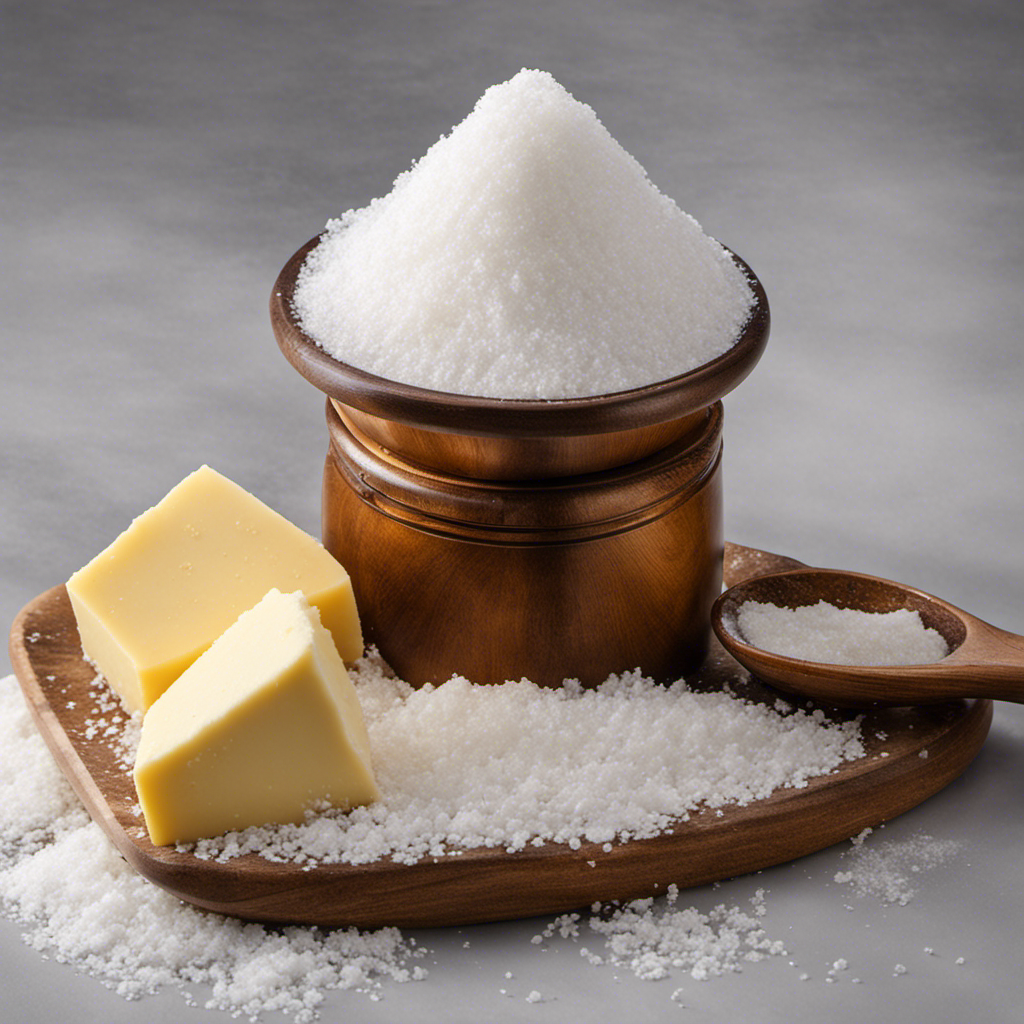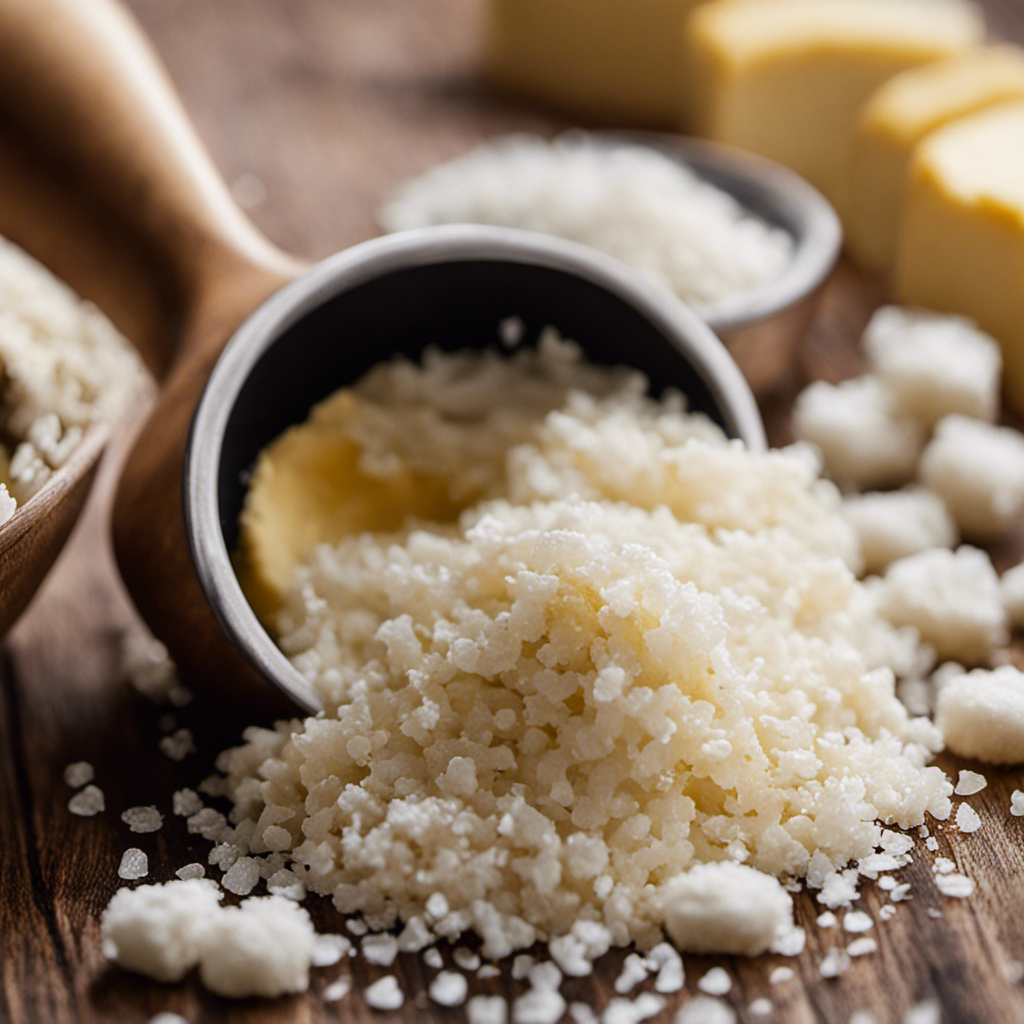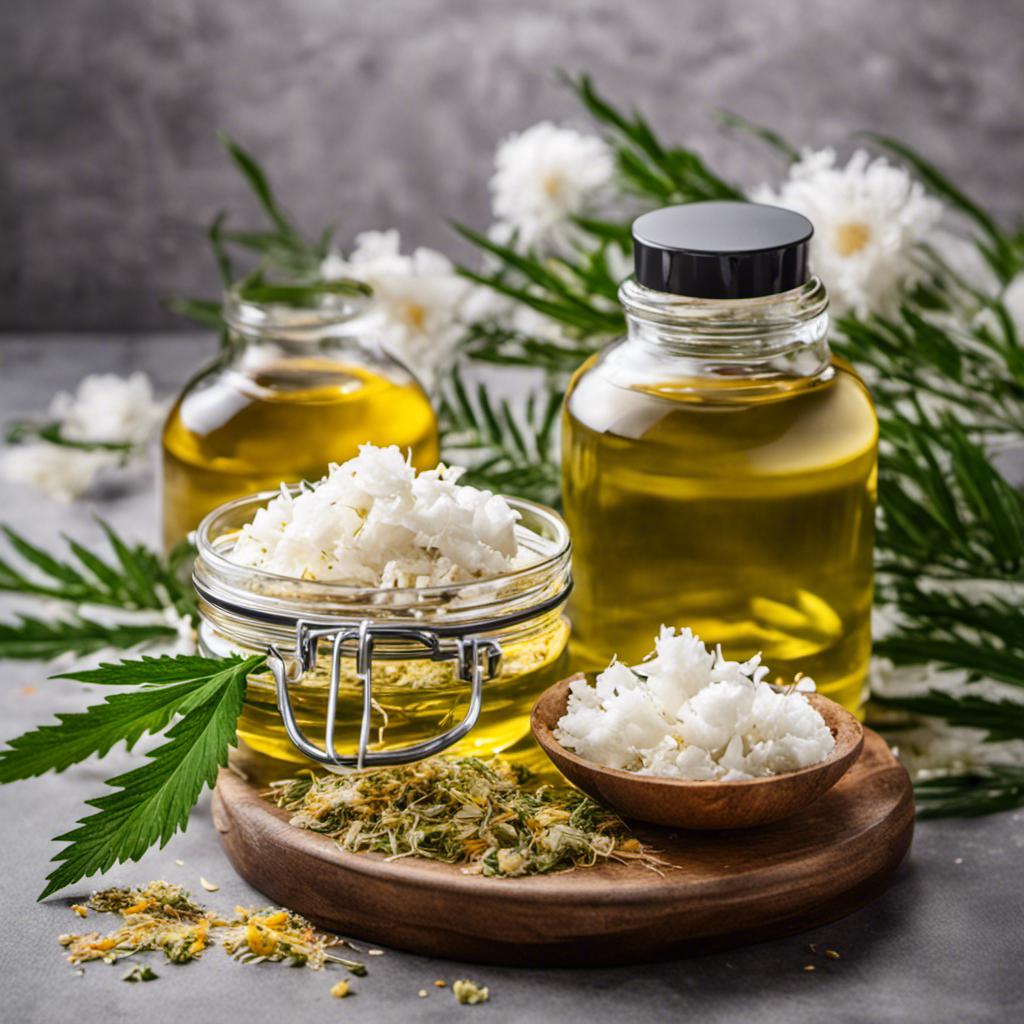As someone with a keen interest in food, I frequently catch myself contemplating the level of salt present in different dishes. Now, I’m focusing my curiosity on salted butter – an essential ingredient in numerous households.
Have you ever wondered how much salt is actually in salted butter? In this informative article, we will delve into the difference between salted and unsalted butter, explore the role of salt in butter production, and examine the impact of salt on the taste of salted butter.
Get ready to uncover the mysteries of salted butter and its salt content.
Key Takeaways
- Salted butter contains around 1-2% salt, which acts as a preservative and enhances the flavor of the butter.
- Salt in butter extends its shelf life by inhibiting bacterial growth and reducing water activity.
- The preservative properties of salt in salted butter prevent oxidation, rancidity, and spoilage.
- Salted butter adds complexity and depth to dishes, but it is important to be mindful of salt intake and choose brands with lower salt levels for a balanced diet.
The Difference Between Salted and Unsalted Butter
The main difference between salted and unsalted butter is the amount of salt added. Salted butter contains a certain percentage of salt, usually around 1-2%, while unsalted butter is made without any added salt.
The addition of salt in butter production serves several important purposes. Firstly, salt acts as a preservative, extending the shelf life of the butter by inhibiting the growth of bacteria. Secondly, salt enhances the flavor of butter, giving it a savory taste that can complement a variety of dishes. Lastly, salt also affects the texture and consistency of butter, contributing to its spreadability and creaminess.
When choosing between salted and unsalted butter, it ultimately depends on personal preference and the specific recipe being prepared.
The Role of Salt in Butter Production
When it comes to butter production, salt plays a crucial role due to its preservative properties and flavor enhancement.
The preservative properties of salt help to extend the shelf life of butter by inhibiting the growth of bacteria and other microorganisms.
Additionally, salt enhances the flavor of butter by balancing its richness and bringing out its natural taste.
Salt’s Preservative Properties
You might be surprised by how salt in salted butter helps to preserve it and extend its shelf life. The preservative effects of salt are due to its ability to draw out moisture from the butter, making it less susceptible to bacterial growth. Here are four ways in which the sodium content in salted butter contributes to its preservation:
- Salt acts as a natural antimicrobial agent, inhibiting the growth of bacteria and molds.
- It reduces the water activity in the butter, making it less hospitable for microbial growth.
- Salt helps to maintain the texture and flavor of butter by preventing oxidation and rancidity.
- It also enhances the overall stability of the butter, preventing it from spoiling quickly.
With the preservative properties of salt, butter can last longer on the shelf, ensuring its freshness and quality.
Now, let’s explore how salt in salted butter enhances its flavor.
Flavor Enhancement in Butter
Adding salt to butter enhances its flavor by bringing out the natural richness and depth of the buttery taste. Salt acts as a flavor enhancer, enhancing the overall flavor profile of butter by balancing its creaminess with a touch of savory goodness. This flavor enhancement makes salted butter a popular choice in culinary applications, as it adds complexity and depth to various dishes.
Whether it’s used in baking, cooking, or simply spread on a slice of bread, the addition of salt elevates the taste experience. However, it’s important to understand the salt content labels on salted butter. This knowledge allows us to make informed decisions about our salt intake and ensure that we are using the right amount of salted butter in our recipes.
Understanding Salt Content Labels on Salted Butter
To understand the salt content labels on salted butter, it’s important to check the nutritional information. Here’s a quick rundown of what to look for:
-
Serving size: This tells you the recommended portion size for accurate nutritional calculations.
-
Calories: Salted butter is high in calories, so it’s important to be mindful of your intake.
-
Fat content: Salted butter is made from cream, which is high in saturated fat. Keep an eye on this if you’re watching your fat intake.
-
Sodium: This is the key element when it comes to salted butter. The sodium content can vary between brands, so check the labels to find the one that suits your dietary needs.
Understanding the production process and the nutritional value of salted butter can help you make informed choices for a healthy diet.
How Salt Affects the Taste of Salted Butter
When it comes to salted butter, the addition of salt not only enhances the flavor but also has an impact on the texture of the butter. Salt acts as a preservative, extending the shelf life of butter by inhibiting the growth of bacteria.
It also helps to stabilize the structure of the butter, giving it a firmer consistency. The amount of salt used in salted butter can vary, but it is typically around 1-2% of the total weight of the butter. This small amount of salt is enough to provide a pleasant, savory taste without overpowering the natural sweetness of the butter.
The history of salted butter dates back centuries, when salt was used as a means of preserving butter during long periods of storage and transportation. Today, salted butter continues to be popular for its unique flavor and versatility in cooking and baking.
Comparing Salt Levels in Different Brands of Salted Butter
Comparing the salt levels in different brands of salted butter can help consumers choose a product that aligns with their taste preferences. When it comes to salted butter, the amount of salt used can vary between brands. Here are four key aspects to consider when comparing salt levels:
-
Sodium content: Check the nutrition label to determine the amount of sodium in each serving of butter. This will give you an idea of how salty the butter will taste.
-
Taste test: Try different brands of salted butter to compare their flavor profiles. Some brands may have a stronger or milder salty taste, allowing you to find the one that suits your preferences.
-
Health considerations: If you are watching your sodium intake, opt for a brand with lower salt levels. This will help you maintain a balanced diet and reduce the risk of health issues associated with excessive sodium consumption.
-
Recipe compatibility: Consider the specific recipes you plan to use the salted butter in. Some recipes may require less or more salt, so choosing a brand with the appropriate salt level can enhance the overall taste of your dishes.
The Recommended Daily Salt Intake and Salted Butter
After comparing the salt levels in different brands of salted butter, it is important to consider the recommended daily sodium intake and the effects of excessive salt intake.
The recommended daily sodium intake for most adults is no more than 2,300 milligrams, or about one teaspoon of salt. Consuming excessive amounts of salt can lead to various health problems, including high blood pressure, heart disease, and stroke.
Salted butter, as the name suggests, contains added salt for flavor. While it can contribute to our daily sodium intake, it is not the main source of excessive salt in our diets.
It is essential to be mindful of our overall salt consumption and make healthier choices in our diet.
Now, let’s explore the health concerns and benefits of salted butter.
Health Concerns and Benefits of Salted Butter
To make healthier choices in your diet, it’s important to consider the health concerns and benefits of consuming salted butter. While salted butter can add flavor to your dishes, it’s essential to be aware of its impact on your health. Here are some health risks and nutritional values associated with salted butter:
-
High sodium content: Salted butter contains a significant amount of sodium, which can contribute to high blood pressure and increase the risk of heart disease.
-
Vitamin A and D: Salted butter is a good source of these fat-soluble vitamins, which are essential for maintaining healthy eyesight, skin, and immune system.
-
Fat content: Salted butter is high in saturated fats, which can raise cholesterol levels and increase the risk of cardiovascular diseases.
-
Flavor enhancement: The salt in salted butter can enhance the taste of various dishes, making them more enjoyable to consume.
Considering these factors, it is advisable to consume salted butter in moderation and opt for healthier alternatives when possible.
Tips for Reducing Salt Intake When Using Salted Butter
When using salted butter, you can reduce your salt intake by opting for unsalted alternatives or using other flavor-enhancing ingredients. Salted butter contains added salt, which can contribute to high sodium intake and increase the risk of health issues such as high blood pressure. By choosing unsalted butter, you have control over the amount of salt in your diet. Alternatively, you can enhance the flavor of unsalted butter by adding herbs, spices, or citrus zest. These flavor-enhancing ingredients not only provide a delicious taste but also offer additional health benefits. For example, herbs like rosemary and thyme contain antioxidants, while citrus zest adds a refreshing burst of vitamin C. By making these simple swaps and additions, you can enjoy the rich taste of butter while reducing your sodium intake and exploring healthier options.
| Healthy Butter Options | Flavor Profile | Health Benefits |
|---|---|---|
| Unsalted Butter | Neutral | Control over salt intake, customizable flavor |
| Grass-fed Butter | Rich, creamy | Higher omega-3 fatty acids, vitamin K2 |
| Plant-based Butter | Varies | Lower in saturated fat, cholesterol-free |
| Ghee | Nutty, caramel | Lactose-free, rich in fat-soluble vitamins |
Exploring Alternatives to Salted Butter for Low-Sodium Diets
If you’re looking to reduce your sodium intake, exploring alternatives to salted butter can provide you with customizable flavor profiles and added health benefits. Here are some low sodium seasoning options to consider when cooking with unsalted butter:
-
Herbs and spices: Experiment with a variety of herbs and spices to add flavor to your dishes. Some popular options include garlic, onion powder, oregano, thyme, and paprika.
-
Citrus zest: Grate the zest of citrus fruits like lemons, limes, or oranges to infuse your dishes with a burst of fresh, tangy flavor.
-
Vinegars: Different types of vinegar, such as balsamic, apple cider, or rice vinegar, can add acidity and depth to your meals without adding sodium.
-
Homemade seasoning blends: Create your own low sodium seasoning blends by combining herbs, spices, and other flavorful ingredients like dried mushrooms or nutritional yeast.
Frequently Asked Questions
Can I Use Unsalted Butter Instead of Salted Butter in Baking Recipes?
Yes, you can use unsalted butter instead of salted butter in baking recipes. However, the flavor may be slightly different as the salt in salted butter adds a savory element to the dish.
How Does the Salt Content in Salted Butter Affect the Texture of Baked Goods?
The salt content in salted butter can have a significant impact on the texture of baked goods. It affects the dough by enhancing gluten development, resulting in a chewier and more flavorful cookie.
Are There Any Health Benefits to Consuming Salted Butter?
Consuming salted butter in moderation can lead to health risks due to its high salt content. It may negatively impact cholesterol levels, increasing the risk of heart disease. It’s important to be mindful of salt intake for overall health.
Can I Reduce the Salt Content in Salted Butter by Rinsing It With Water?
Reducing salt in butter can be achieved by rinsing it with water. However, this may affect the taste and texture. It is important to note that the amount of salt in salted butter varies by brand.
What Are Some Low-Sodium Alternatives to Salted Butter for Those on a Low-Sodium Diet?
Low-sodium spreads and salted butter substitutes are great options for those on a low-sodium diet. They provide flavor without the excess sodium. These alternatives can be found in most grocery stores.
Conclusion
In conclusion, it’s clear that the amount of salt in salted butter varies from brand to brand. Understanding the role of salt in butter production and its impact on taste is crucial. Salted butter can add a delightful savory touch to dishes, but it’s important to be mindful of our daily salt intake. For those seeking alternatives, exploring low-sodium options can be a healthier choice.
So let’s savor the richness of salted butter, but with moderation and consideration for our well-being.










